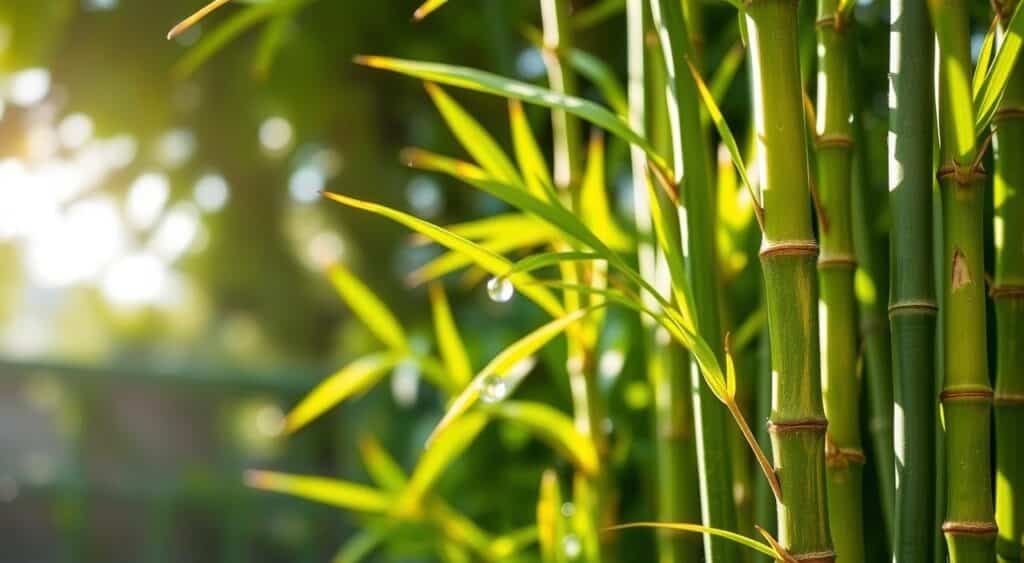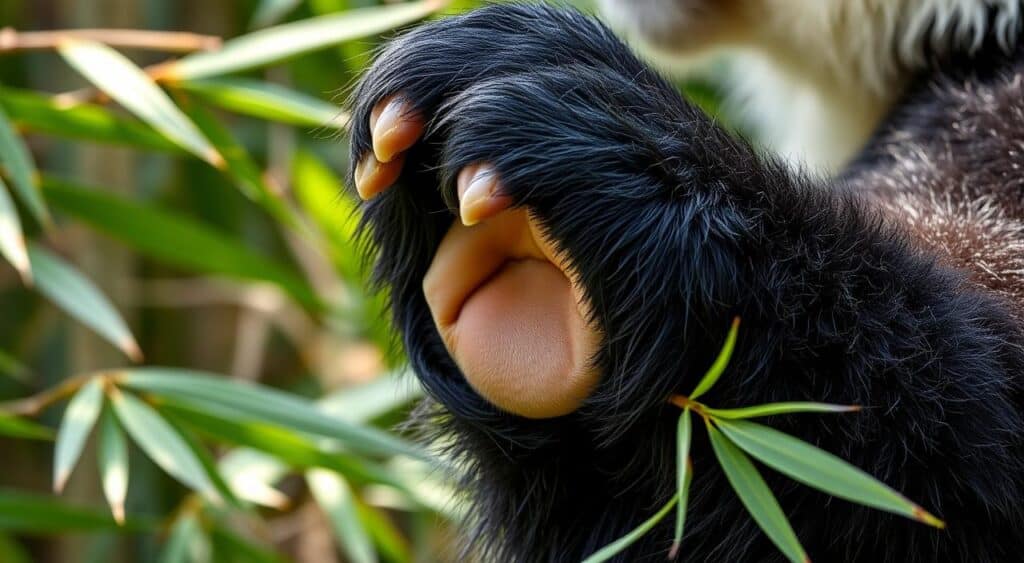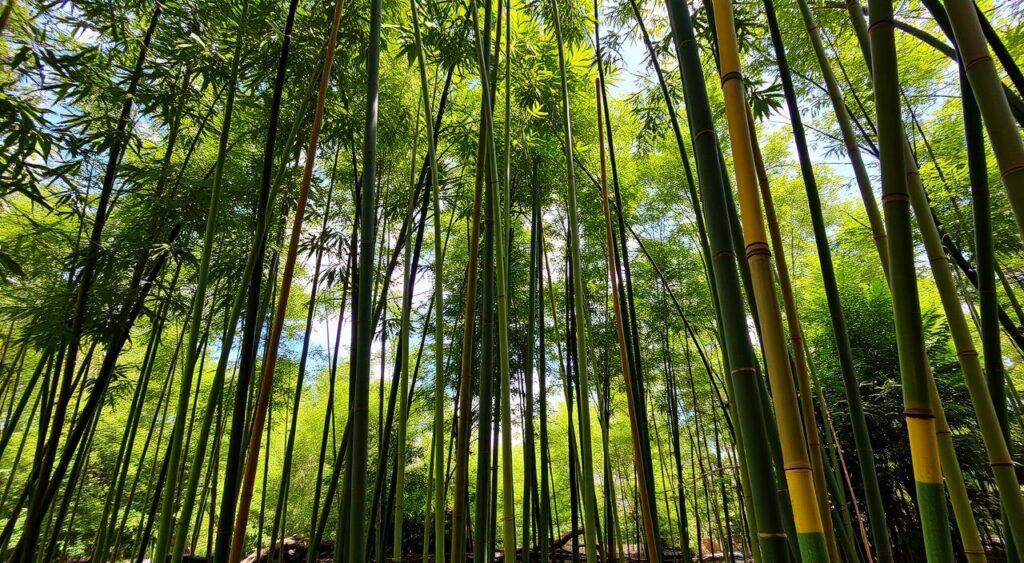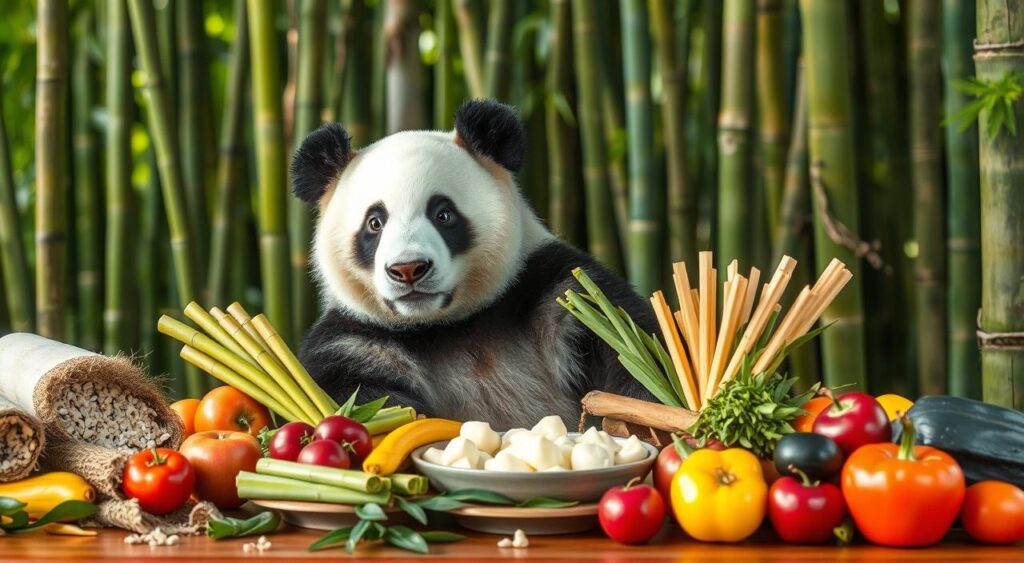Bamboo Diet Benefits: Pandas are loved for their black and white fur. They live in bamboo forests in China. Their diet is mostly bamboo, which is key to their survival.
In zoos, pandas eat bamboo for up to 75% of their diet. Wild pandas eat 10 to 15 kilograms of bamboo daily. This means they eat more than their body weight in bamboo every two weeks.
Scientists believe pandas started eating bamboo about 4 million years ago. This shows how long pandas and bamboo have been connected.
Key Takeaways
- Pandas consume up to 75% of their diet from bamboo, both in captivity and in the wild.
- Wild pandas can eat 10-15 kilograms of bamboo per day, consuming their own body weight in a fortnight.
- Pandas’ adaptation to bamboo as their primary food source dates back approximately 4 million years.
- Bamboo provides pandas with limited calories, which is why they don’t hibernate like other bear species.
- Pandas have a specialized diet that depends on the availability and abundance of bamboo in their habitats, contributing to the threat of extinction.
The Importance of Bamboo in a Panda’s Diet
Bamboo is key to a panda’s diet, making up almost 99% of what they eat. This is because bamboo is plentiful and easy to find in their natural home. Bamboo gives pandas the nutrients they need, even though it has fewer calories.
Bamboo: A Nutritious and Energy-Rich Food Source
Bamboo may not have many calories, but it’s packed with nutrients pandas need to live. Over time, pandas have developed strong jaws and teeth. These help them break down bamboo and get the nutrients they need.
Hydration Source: Bamboo’s Water Content
Bamboo is not just food for pandas; it’s also a big source of water. This is surprising, given pandas are more like meat-eaters. But they rely on bamboo for most of their water.
Helping giant pandas means protecting their bamboo homes. Bamboo is vital for pandas to stay healthy and reproduce. This shows how important bamboo is for pandas’ survival.
“Pandas consume between 26 to 84 pounds of bamboo daily to meet their energy and nutritional needs.”
Bamboo Diet Benefits

Bamboo might seem simple, but it’s packed with nutrients for pandas. Bamboo shoots, leaves, and stems have carbs, proteins, and fiber for growth and survival. It’s also full of minerals like calcium, magnesium, and potassium for health.
Carbohydrates, Proteins, and Fiber: Essential Nutrients from Bamboo
One cup of cooked bamboo shoots has about 64 calories. It has 2.5 grams of protein, 4.5 grams of fat, and 5 grams of carbohydrates. The fiber in bamboo helps with digestion, especially for pandas with short digestive tracts.
Mineral Richness: Calcium, Magnesium, and Potassium
Bamboo shoots are a great source of minerals like calcium, magnesium, and potassium. These minerals are key for pandas’ bone health and overall well-being.
| Nutrient | Amount per 1 cup (155g) of Cooked Bamboo Shoots | Percentage of Daily Value (DV) |
|---|---|---|
| Calories | 64 | – |
| Protein | 2.5g | – |
| Carbohydrates | 5g | – |
| Fiber | 2g | 7% |
| Copper | 0.4mg | 19% |
| Vitamin B6 | 0.2mg | 14% |
| Vitamin E | 1.4mg | 9% |
The fiber in bamboo shoots is 2 grams per serving. It’s good for gut health and can help with weight loss. It also helps with regular bowel movements, preventing issues like hemorrhoids and colorectal cancer.
“Bamboo shoots are a good source of nutrients such as potassium, calcium, manganese, zinc, chromium, copper, iron, thiamine, niacin, vitamin A, vitamin B6, and vitamin E.”
Challenges of a Bamboo-Based Diet

Bamboo is key in a panda’s diet, but it comes with challenges. Pandas struggle with low nutrient density in bamboo, needing to eat a lot to get enough energy. They also face issues with seasonal availability and species variation of bamboo.
Low Nutrient Density and High Volume Consumption
Bamboo is not very nutritious, so pandas must eat a lot to get enough energy. This means they spend up to 14 hours a day eating bamboo. The bamboo nutrient density and panda food intake make it hard for pandas to get the nutrients they need.
Seasonal Availability and Species Variation
Bamboo is only available at certain times of the year, forcing pandas to adjust their eating habits. Also, bamboo species vary in what they offer nutritionally. This makes it tough for pandas to keep their diet balanced and consistent.
“The nutritional components of different bamboo shoots were compared, indicating geographic variations in nutrient content that can impact dietary choices.” (Chen et al., 1999)
Pandas face many hurdles to survive on bamboo. They have developed special ways to deal with these issues, showing their amazing adaptability.
Panda Adaptations to the Bamboo Diet

Giant pandas have adapted well to their bamboo diet. Their strong jaws and teeth are perfect for chewing bamboo. This lets them get the most nutrients from their main food.
Powerful Jaws and Robust Teeth for Chewing Bamboo
Pandas have strong muscles in their jaws. Their flat molars crush bamboo stems. This helps them eat a lot of bamboo every day.
The “Pseudo-Thumb” for Gripping Bamboo Shoots
Pandas also have a special wrist bone, like a “pseudo-thumb”. It helps them hold bamboo shoots and leaves. This is key since their diet is mostly bamboo, despite their body being made for meat.
Pandas’ strong jaws, teeth, and wrist bone show how they’ve adapted to bamboo. These features help them survive on bamboo for millions of years.
Bamboo Varieties Consumed by Pandas

Pandas can eat many types of bamboo. They like arrow bamboo and black bamboo best. But they also eat over 20 other kinds. This helps them find food when bamboo is scarce.
They eat different bamboo to get lots of nutrients. Studies show they mainly eat Phyllostachys bissetii, Bashania fargesii, and Qiongzhuea opienensis. This variety is key to their health.
Each bamboo type has its own nutrients. The culm group has lots of calories and fiber. But it’s not as energy-rich as the shoot group. The shoot group, on the other hand, has more protein and helps pandas grow faster.
Pandas choose bamboo based on sunlight exposure and seasonal variations. They prefer bamboo in sunny spots. They also change what they eat with the seasons.
This shows how important it is to protect bamboo forests. By growing many bamboo types, we help pandas get the nutrients they need. This is crucial for their survival.
Creating a Balanced Meal Plan for Pandas

Creating a balanced meal plan is key for pandas’ health, especially in captivity. Bamboo is their main food, but they also need other foods for vitamins and minerals. This ensures they get all the nutrients they need.
Supplementing with Fruits, Vegetables, and Nutrient-Rich Biscuits
Pandas also benefit from fresh fruits and vegetables, along with special biscuits. These foods add to their diet and help prevent any nutrient gaps. This makes their diet more balanced.
- Fruits and vegetables add vitamins, minerals, and antioxidants to their diet.
- Nutrient-rich biscuits are made to meet pandas’ specific needs, ensuring they get the right food.
- The bamboo diet should be supplemented carefully to match their natural diet, meeting each panda’s needs.
Zoos and conservation centers can keep pandas healthy by adding a variety of nutritious foods to their diet. This helps them stay healthy in captivity and in the wild.
“Eating healthfully means eating what’s right for you based on your age, food sensitivities, and medical conditions.”
– Dr. David Katz, MD
| Nutrient | Importance for Pandas | Food Sources |
|---|---|---|
| Carbohydrates | Provide energy for bamboo digestion and foraging activities | Bamboo, fruits, vegetables, nutrient-rich biscuits |
| Protein | Support muscle growth and maintenance | Bamboo, nutrient-rich biscuits, occasional small prey |
| Fiber | Promote healthy digestion and gut function | Bamboo, fruits, vegetables |
| Vitamins and Minerals | Ensure overall health and well-being | Fruits, vegetables, nutrient-rich biscuits |
Also Read: Panda Bamboo Diet: Facts And Nutritional Needs
Conclusion
The panda’s bamboo-based diet is amazing. It lets these animals live and grow in their bamboo habitat. Bamboo gives pandas the nutrients and water they need, keeping them healthy.
Even though bamboo is not always easy to eat, pandas have found ways to make it work. They have strong jaws, teeth, and a special “pseudo-thumb.” This helps them hold and eat bamboo shoots.
It’s important to mimic the panda diet importance in zoos. This helps keep pandas safe and healthy. By adding other nutrients to their bamboo diet, we help pandas everywhere. This way, we can ensure pandas continue to thrive, inspiring us to protect their homes and their future.
FAQs
Source Links
- https://pandathings.com/learn-about-the-giant-panda/why-do-pandas-eat-bamboo/
- https://www.bamboogrove.com/blog/bamboo-news/the-perfect-meal-plan-for-pandas-unlocking-the-power-of-bamboo-diets/
- https://www.reelpaper.com/blogs/reel-talk/why-do-pandas-eat-bamboo?srsltid=AfmBOoqvQhGeKwg53niF6r3Xw9Fb7X5Gzrj0SFw1lWf82VXPKm0oX-i4

